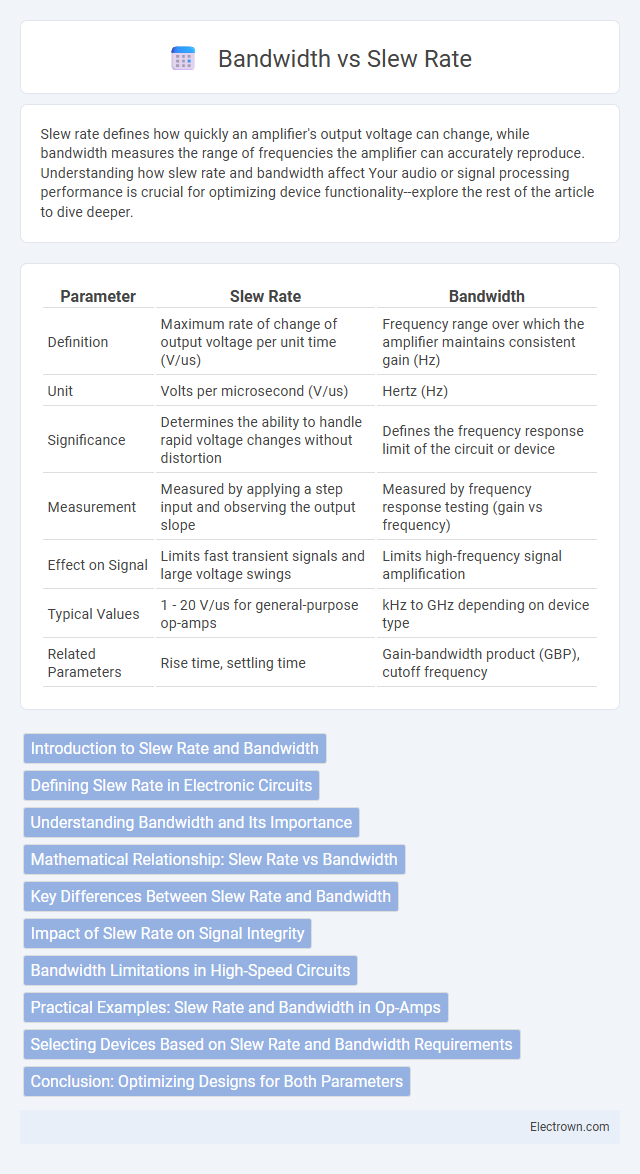Slew rate defines how quickly an amplifier's output voltage can change, while bandwidth measures the range of frequencies the amplifier can accurately reproduce. Understanding how slew rate and bandwidth affect Your audio or signal processing performance is crucial for optimizing device functionality--explore the rest of the article to dive deeper.
Table of Comparison
| Parameter | Slew Rate | Bandwidth |
|---|---|---|
| Definition | Maximum rate of change of output voltage per unit time (V/us) | Frequency range over which the amplifier maintains consistent gain (Hz) |
| Unit | Volts per microsecond (V/us) | Hertz (Hz) |
| Significance | Determines the ability to handle rapid voltage changes without distortion | Defines the frequency response limit of the circuit or device |
| Measurement | Measured by applying a step input and observing the output slope | Measured by frequency response testing (gain vs frequency) |
| Effect on Signal | Limits fast transient signals and large voltage swings | Limits high-frequency signal amplification |
| Typical Values | 1 - 20 V/us for general-purpose op-amps | kHz to GHz depending on device type |
| Related Parameters | Rise time, settling time | Gain-bandwidth product (GBP), cutoff frequency |
Introduction to Slew Rate and Bandwidth
Slew rate refers to the maximum rate of change of an amplifier's output voltage per unit time, typically measured in volts per microsecond (V/us). Bandwidth defines the range of frequencies over which an amplifier or system can operate effectively without significant signal attenuation. Understanding the balance between slew rate and bandwidth is crucial for optimizing Your circuit's performance, ensuring signal fidelity at high frequencies.
Defining Slew Rate in Electronic Circuits
Slew rate in electronic circuits defines the maximum rate of change of an amplifier's output voltage per unit time, typically measured in volts per microsecond (V/us). It directly impacts the ability of the circuit to accurately reproduce high-frequency signals without distortion or signal clipping. Unlike bandwidth, which refers to the range of frequencies an amplifier can handle, slew rate specifically limits the speed at which output voltage can change, crucial for high-speed or fast transient response applications.
Understanding Bandwidth and Its Importance
Bandwidth in electronic circuits refers to the range of frequencies a device can process effectively without significant signal degradation. It determines the maximum frequency at which a system can operate while maintaining signal integrity. Understanding bandwidth is crucial for optimizing performance, as insufficient bandwidth limits the speed and fidelity of signal transmission.
Mathematical Relationship: Slew Rate vs Bandwidth
The mathematical relationship between slew rate (SR) and bandwidth (BW) is defined by the formula SR = 2p x BW x Vp, where Vp represents the peak output voltage. This equation indicates that the slew rate limits the maximum frequency at which an amplifier can output a signal of a given amplitude without distortion. Understanding this relationship is crucial for optimizing your amplifier's performance in high-speed signal applications.
Key Differences Between Slew Rate and Bandwidth
Slew rate defines the maximum rate of change of an operational amplifier's output voltage per unit time, typically measured in volts per microsecond (V/us), while bandwidth refers to the range of frequencies an amplifier can effectively handle without significant signal attenuation. Slew rate primarily impacts the amplifier's ability to accurately reproduce fast transient signals without distortion, whereas bandwidth determines the frequency limits within which the amplifier maintains consistent gain. Understanding these distinctions is crucial for optimizing amplifier performance in high-speed and high-frequency applications.
Impact of Slew Rate on Signal Integrity
Slew rate directly affects signal integrity by limiting how quickly an amplifier or circuit can respond to rapid voltage changes, impacting the faithful reproduction of high-frequency signals. Insufficient slew rate causes distortion known as slew rate limiting, which degrades waveform accuracy and reduces effective bandwidth. High slew rates enable better handling of fast transient signals, preserving signal quality and minimizing harmonic distortion in high-speed communication and audio systems.
Bandwidth Limitations in High-Speed Circuits
High-speed circuits face bandwidth limitations primarily due to the finite slew rate of amplifiers, which restricts the maximum rate of voltage change and thus limits the frequency response. As slew rate decreases, signal distortion increases at higher frequencies, reducing effective bandwidth and compromising signal integrity. Designers must balance slew rate and bandwidth to optimize performance in applications such as communication systems and high-speed data converters.
Practical Examples: Slew Rate and Bandwidth in Op-Amps
In practical op-amp applications, slew rate determines how quickly the output voltage can change, directly affecting signal fidelity at high frequencies, while bandwidth limits the range of frequencies the amplifier can handle without distortion. For audio amplifiers, a high slew rate prevents signal distortion during rapid transients, and a wide bandwidth ensures accurate reproduction of the entire audible range. Understanding these parameters helps you select an op-amp capable of maintaining signal integrity in fast, high-frequency circuits.
Selecting Devices Based on Slew Rate and Bandwidth Requirements
Selecting devices based on slew rate and bandwidth requirements is critical for ensuring signal integrity in high-speed applications. A device with an insufficient slew rate can cause signal distortion, limiting the maximum frequency it can accurately reproduce despite having adequate bandwidth. Prioritizing devices where the slew rate exceeds the product of the maximum input frequency and peak output voltage ensures both fast response and frequency coverage, optimizing overall system performance.
Conclusion: Optimizing Designs for Both Parameters
Balancing slew rate and bandwidth is essential for achieving high-performance electronic circuit designs. Maximizing slew rate ensures rapid signal transitions, while optimizing bandwidth maintains signal integrity across relevant frequencies. Your design choices should prioritize both parameters based on application requirements to enhance overall system efficiency and accuracy.
slew rate vs bandwidth Infographic

 electrown.com
electrown.com